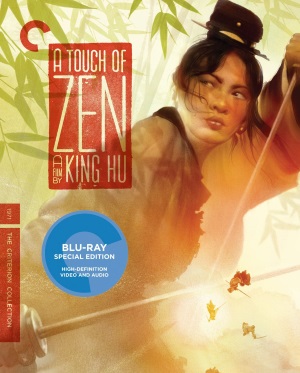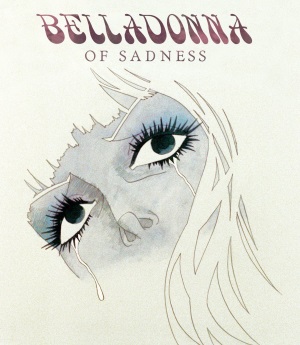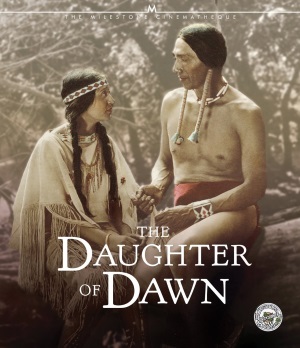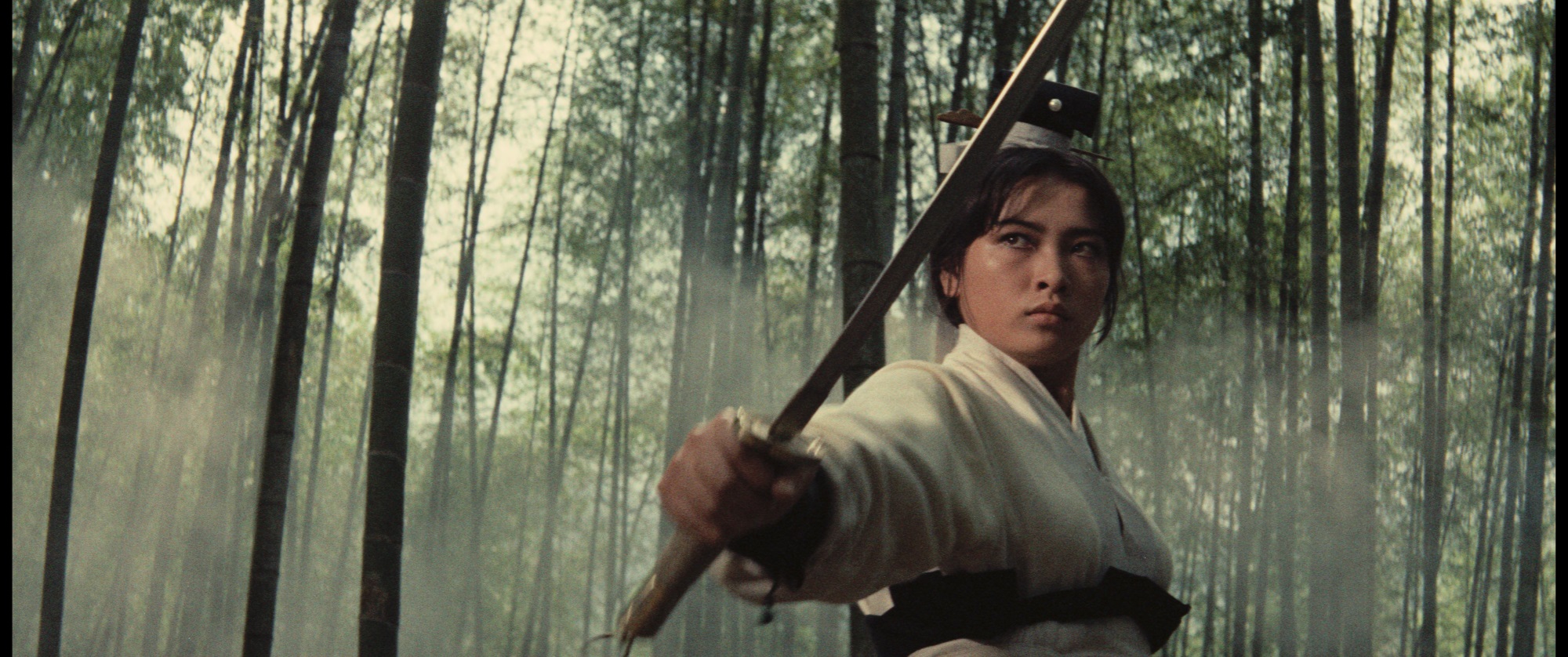 A Touch of Zen (Criterion, Blu-ray, DVD), King Hu’s romantic chivalry adventure, is a masterpiece of Hong Kong cinema, a magnificent epic with grand battles fought with the grace of a ballet with swords, and the most significant cinematic inspiration for Ang Lee’s Crouching Tiger, Hidden Dragon. The three-hour film took the uniquely Chinese genre of wuxia pian (literally “martial chivalry”), a genre he practically defined with Come Drink With Me (1966) and Dragon Gate Inn (1967), into the realms of poetry and epic adventure. 45 years after its completion, A Touch of Zen has been restored and it is as glorious and grand and dreamily beautiful as ever.
A Touch of Zen (Criterion, Blu-ray, DVD), King Hu’s romantic chivalry adventure, is a masterpiece of Hong Kong cinema, a magnificent epic with grand battles fought with the grace of a ballet with swords, and the most significant cinematic inspiration for Ang Lee’s Crouching Tiger, Hidden Dragon. The three-hour film took the uniquely Chinese genre of wuxia pian (literally “martial chivalry”), a genre he practically defined with Come Drink With Me (1966) and Dragon Gate Inn (1967), into the realms of poetry and epic adventure. 45 years after its completion, A Touch of Zen has been restored and it is as glorious and grand and dreamily beautiful as ever.
The very opening tells you that this is something different, from the ominous spiderwebs stretched across the dark to a sunrise over the mountains of the rural inland in a remote part of China. There’s six or so minutes of scene-setting, glorious images and music that flow with a sense of grace, before we see a sign of civilization. It’s almost like an intrusion on the purity of this world. Almost. That same slow, sublime storytelling continues as a poor but honorable scholar, Gu (Chun Shih), sets up his shop and welcomes a stranger, who sits for a portrait and asks about some of the recent arrivals in this remote village. When the stranger slips away to follow one of these newcomers, we observe the trajectories of the followed and the followers and see an intelligence network of spies and agents emerge from the lazy rhythms of the sleepy town square. Every new arrival adds to the web, especially a young woman, Yang (Feng Hsu), who moves into the haunted manor next door and a blind beggar (Ying Bai) who suddenly seems to be everywhere.
What begins as a conspiracy and ghost story becomes an ingenious game of tricks and traps sprung in the dark (revealed the next morning in a brilliant scene that instantly transforms a bloodless fantasy and triumph into a shocking confrontation of the brutality of battle) and transforms through floating, leaping, airborne fights into one of the most beautiful martial arts movies you’ve ever seen. Yang is actually a noblewoman on the run from the forces of a corrupt Eunuch, forces that soon enough arrive and inspire Gu to offer his services to Yang and her protectors. Not as a fighter—he’s a scholar, not a soldier—but for tactics and intelligence. Yang, however, is most definitely a fighter, a master martial artist trained in a Buddhist temple who all but flies through the air. When the first battle begins (more than an hour into the film) she and her guardian General dance on the leaves of branches. The promised touch of Zen is introduced by a brotherhood of Monks dedicated to defending the innocent with nothing but bare hands against swords. The acrobatics are more balletic and graceful than athletic: our heroes jump (with the help of hidden trampolines) and somersault through the air, leap up trees and over walls, and land as if floating like a feather to the ground.
Hu accomplishes it through editing and camerawork—this is before the advent of wire-work and digital effects—and a dramatic sense of dynamic composition. The colors are delicate, like they’ve been painted, and the atmosphere is painstakingly created with mist and falling leaves and sunlight that floods the lens and darkness that shrouds the visual world in shadow. Yet even in its most spectacular action Hu creates a sense of serenity and wonder. A Touch of Zen flows like a lazy river with a swirling undertow just beneath the placid surface, and the camera floats along it.
It took two years to complete and was a financial failure when the producers (wary of the way Hu shifted from action spectacle to arthouse grace) released the film in two parts in 1971, and then won an award at Cannes when Hu’s complete cut was screened in 1975. It is now hailed as a masterpiece of Chinese cinema. Also: look for Sammo Hung, long before he made his fame as the “Fat Dragon” of Hong Kong cinema, in a wordless role as a warrior in yellow robes in the third act.
The film was restored in 4K by the Taiwan Film Institute and L’Immagine Ritrovata from the 35 mm original camera negative, a painstaking process of going frame by frame to eliminate stains and spots (some artifacts, possibly tracing back to original negative processing, are still visible), repair tears, and remove splice marks. The restoration was funded by actress Hsu Feng and cinematographer Hua Hui-ying supervised the color grading. Criterion masters their release from this restoration and the results are breathtaking, with intense colors and glorious images.
On Blu-ray and DVD with the 47 minute documentary King Hu: 1932-1997 produced in 2012 for French TV (though it is mostly in English and Cantonese) and new interviews with actors Hsu Feng (13 mins) and Shih Chen (17 mins), who had both appeared in Hu’s earlier Dragon Gate Inn (1967), filmmaker Ang Lee (13 mins), who talks of the film’s legacy and how it inspired Crouching Tiger, Hidden Dragon (2000), and critic and Asian film historian Tony Rayns (34 mins), plus a fold-out insert with an essay by film historian David Bordwell and notes on the film by King Hu.
 Belladonna of Sadness (Cinelicious, Blu-ray), a lost 1973 classic of Japanese animation, is indeed a erotic drama, but it is quite a sophisticated one that is part subversive folk tale, part rock ballad musical, and part experimental filmmaking. Set in an unnamed kingdom in an abstracted medieval Europe, it’s a provocative film about female sexuality in a culture where such expression is considered sinful at best and the work of the devil at worst, and sure enough the holy representative of the church stand by the oppressive ruler to maintain a proper patriarchy in the cursed kingdom. Whatever you want to call it, it’s nothing like the manga serials or sexually explicit anime horrors that comes to mind in the intersection of Japan, animation, and erotica. This has more in common with such animated outliers as Fantastic Planet (France, 1973) and the early features of Ralph Bakshi, and the Czech new wave masterpiece Valerie and Her Week of Wonders (1970).
Belladonna of Sadness (Cinelicious, Blu-ray), a lost 1973 classic of Japanese animation, is indeed a erotic drama, but it is quite a sophisticated one that is part subversive folk tale, part rock ballad musical, and part experimental filmmaking. Set in an unnamed kingdom in an abstracted medieval Europe, it’s a provocative film about female sexuality in a culture where such expression is considered sinful at best and the work of the devil at worst, and sure enough the holy representative of the church stand by the oppressive ruler to maintain a proper patriarchy in the cursed kingdom. Whatever you want to call it, it’s nothing like the manga serials or sexually explicit anime horrors that comes to mind in the intersection of Japan, animation, and erotica. This has more in common with such animated outliers as Fantastic Planet (France, 1973) and the early features of Ralph Bakshi, and the Czech new wave masterpiece Valerie and Her Week of Wonders (1970).
From abstract sexual imagery to strobing Peter Max pop art designs to delicate watercolors and Euro-style sketches, this animated feature—restored to its full length and to its visual vibrancy and intensity by Cinelicious—is a unique artifact from a time when animated features could aspire to fine art and experimentation for adult audiences. You’d never guess that it’s from producer Osamu Tezuka (creator of Astro Boy and Kimba the White Lion) and director Eiichi Yamamoto, his longtime collaborator.
Features new video interviews with director Yamamoto, art director Kuni Fukai, and composer Masahiko Satoh and a booklet with an essay by Dennis Bartok.
 The Daughter of Dawn (Milestone, Blu-ray, DVD), produced in 1920 in Wichita Mountains of Oklahoma Wildlife Refuge, is a fictional drama of tribal life with a cast made up entirely of Native American Indians, mostly Kiowa and Comanche. The story revolves around a romantic triangle—Kiowa warrior Black Wolf is in love with the daughter of the chief but she loves White Eagle, and a test of courage is undertaken to win her hand—and the conflict with the nearby Comanche tribe, which sends raiding parties into Kiowa territory and kidnaps women for brides, including The Daughter of Dawn.
The Daughter of Dawn (Milestone, Blu-ray, DVD), produced in 1920 in Wichita Mountains of Oklahoma Wildlife Refuge, is a fictional drama of tribal life with a cast made up entirely of Native American Indians, mostly Kiowa and Comanche. The story revolves around a romantic triangle—Kiowa warrior Black Wolf is in love with the daughter of the chief but she loves White Eagle, and a test of courage is undertaken to win her hand—and the conflict with the nearby Comanche tribe, which sends raiding parties into Kiowa territory and kidnaps women for brides, including The Daughter of Dawn.
It is not a documentary but, like the earlier In the Land of the Headhunters (1914), it features culturally accurate costumes, dances, and rituals (all thanks to the native actors and to the producer and adviser Richard E. Banks, who was determined to be true to the culture) and it presents the distinctive beauty of the Wichita Mountains before the encroachment of western civilization. Director Norbert Myles was a veteran screen actor and he draws fine performances from the cast (which includes the son and daughter of the celebrated Comanche chief Quanah Parker) and brings a professionalism to the storytelling and the photography. It is an entertaining adventure and a fascinating and unique piece of American cultural history. The film disappeared soon after its completion and was thought lost for decades until the Oklahoma Historical Society acquired a collector’s print and spent years restoring the film for public showings beginning in 2012. The film was added to the Library of Congress National Film Registry for “culturally, historically, or aesthetically significant” films in 2013.
Blu-ray and DVD, with eight short featurettes on the historical background, rediscovery, and restoration of the film filmed by the Oklahoma Historical Society.

